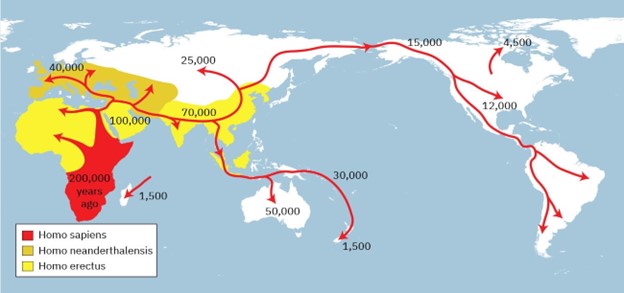1 The Ancient Migration: Unveiling the Global Journey of Early Humans
The epic narrative of human history commences in Africa, approximately 200,000 years ago, when the first Homo sapiens embarked on a monumental migration out of eastern and southern Africa. This initial expansion propelled early humans into uncharted territories, stretching from the southernmost tip of Africa to the Mediterranean Sea’s northern shores. Around 100,000 years ago, a pivotal moment in human history unfolded as groups of Homo sapiens ventured beyond the African continent, initiating a protracted global migration that spanned tens of thousands of years.
As these early migrants traversed the Sinai Peninsula into southwest Asia, they likely followed the Asian coastlines, eventually reaching the Indian subcontinent and China around 70,000 years ago. Some groups continued their southern trajectory, penetrating Malaysia, Indonesia, and beyond. Archaeological evidence reveals settlements in Papua New Guinea and Australia dating back at least 45,000 years, testament to the remarkable resilience and adaptability of early humans.
Concurrently, other groups migrating from northern Africa into southwest Asia entered Europe around 40,000 years ago, navigating either the Mediterranean coastal route or the Turkish passage into the Danube valley. By 25,000 years ago, Homo sapiens had reached the vast expanse of Siberia and northern Asia. Approximately 15,000 years ago, a subset of Asian migrants crossed into North America, eventually reaching the southernmost tip of South America and establishing settlements throughout the intervening regions.
Notably, the presence of early humans in Australia, disconnected from Asia by sea, suggests the utilization of primitive rafts or boats to traverse short island distances. Similarly, the discovery of 14,000-year-old human habitation in South America implies the possibility of coastal navigation using rudimentary watercraft, although concrete evidence of these vessels remains elusive. Nonetheless, the assumption of their existence is essential to understanding the remarkable journey of early humans.

The catalyst for the initial migration of Homo sapiens out of Africa remains a topic of speculation, but climatic factors likely played a significant role. Around 200,000 years ago, Africa’s climate was becoming increasingly arid, leading to a scarcity of resources essential for human survival. As hunter-gatherers, early humans relied on tracking and exploiting available plants and animals, making them vulnerable to environmental fluctuations.
The drying of Africa’s climate may have triggered a gradual migration, as humans sought more hospitable regions with abundant resources. This movement was likely characterized by:
- Gradual dispersal: Human populations migrated over tens of thousands of years, with individual lifetimes barely perceiving the large-scale movement.
- Multi-directional waves: Groups moved back and forth, responding to climatic conditions and resource availability, creating waves of migration in various directions.
- Adaptation and transformation: As humans entered new environments, they adapted their survival strategies to exploit local resources, leading to transformations in their ecosystems.
The arrival of humans in new regions often coincided with significant changes, including the decline of large animal species. In Australia, for example, the arrival of humans around 45,000 years ago was followed by the extinction of megafauna, such as giant reptiles, marsupial lions, and large wombats and kangaroos. This suggests that human hunting practices may have contributed to these extinctions, highlighting the profound impact of early human migration on the planet’s ecosystems.
